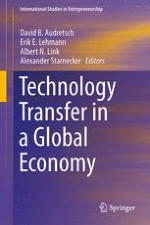2012 | OriginalPaper | Chapter
6. Introducing the University of Applied Science in the Technology Transfer Process
Authors : Erik E. Lehmann, Alexander Starnecker
Published in: Technology Transfer in a Global Economy
Publisher: Springer US
Activate our intelligent search to find suitable subject content or patents.
Select sections of text to find matching patents with Artificial Intelligence. powered by
Select sections of text to find additional relevant content using AI-assisted search. powered by
